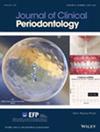Saliva Versus All-Site Microbiome and Proteome Mapping in Periodontitis
Abstract
Aim
Saliva is a diagnostic surrogate for microbial and host biomarkers in periodontitis, but whether it reflects subgingival plaque, gingival crevicular fluid (GCF) or serum remains debated. This study profiled GCF and subgingival plaque from all sites of periodontitis patients, comparing them to saliva and serum.
Materials and Methods
Saliva, serum, subgingival plaque and GCF were obtained from three patients with stage III, grade C periodontitis, having 23, 25 and 27 teeth, respectively, with six sites sampled per tooth. All plaque and GCF samples were pooled per patient. Shotgun sequencing and mass spectrometry proteomics were used for microbiome and proteome analysis, respectively.
Results
Totally 277 microbial taxa were collectively identified in saliva and plaque, 93 of which were differentially abundant between the two. Saliva exhibited higher overall species diversity, but lower periodontal pathogen abundance. A total of 1153 host proteins were identified (saliva: 803; GCF: 932; serum: 195) across the three biological fluids, with 685 shared among saliva and GCF and 109 among all three. Saliva contained slightly fewer proteins than GCF, but shared several common immune, metabolic and enzyme regulation pathways.
Conclusion
Saliva is effective for broad microbiome and proteome screening; whereas plaque delivers greater precision in identifying specific periodontal pathogens directly associated with a periodontal pocket.


 求助内容:
求助内容: 应助结果提醒方式:
应助结果提醒方式:


